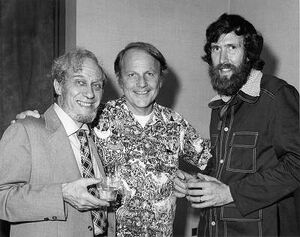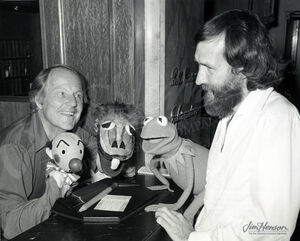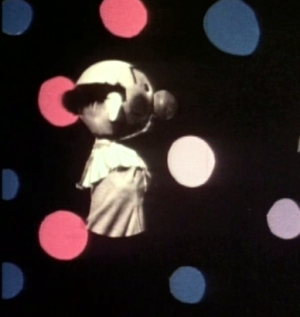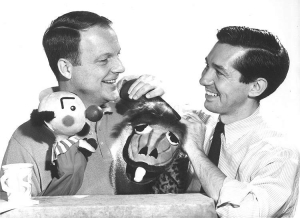(→Legacy) |
GonzosNoze (talk | contribs) No edit summary |
||
| Line 1: | Line 1: | ||
| − | [[Image:Hensonburr.jpg|thumb|300px|Bil Baird, Burr Tillstrom, and Jim Henson at the National Puppetry Festival, circa |
+ | [[Image:Hensonburr.jpg|thumb|300px|Bil Baird, Burr Tillstrom, and Jim Henson at the National Puppetry Festival, circa 1973.]] |
| − | [[Image: |
+ | [[Image:JH_BurrTilstrom_0011.jpg|thumb|300px|Tillstrom with Kukla and Ollie and Jim Henson with Kermit the Frog, 1977.]] |
| − | [[Image: |
+ | [[Image:Kukla.jpg|thumb|300px|Kukla, as seen in the mind of The Floating Face]] |
| + | [[Image:Donburr.jpg|thumb|300px|Burr Tillstrom and Don Sahlin with Kukla and Ollie.]] |
||
'''Burr Tillstrom''' (1917-1985) was a puppeteer best known as the creator of the early television series ''Kukla, Fran, and Ollie.'' Tillstrom created his first puppet, a clown character who would be named Kukla following an encounter with a Russian ballerina, in 1936. His troupe of "Kuklapolitans" expanded in 1938 to include Oliver J. Dragon ("Ollie"). The group performed on early television broadcasts in 1939 and 1942. With the addition of [[Illinois|Chicago]] actress [[Fran Allison]], the program premiered as ''Junior Jamboree'' in 1947 and was soon renamed ''Kukla, Fran, and Ollie'', remaining on the air until 1957 and with several subsequent revivals. Tillstrom also performed on the satirical political series ''That Was the Week That Was'', winning an [[Emmy]] for his Berlin Wall hand ballet. |
'''Burr Tillstrom''' (1917-1985) was a puppeteer best known as the creator of the early television series ''Kukla, Fran, and Ollie.'' Tillstrom created his first puppet, a clown character who would be named Kukla following an encounter with a Russian ballerina, in 1936. His troupe of "Kuklapolitans" expanded in 1938 to include Oliver J. Dragon ("Ollie"). The group performed on early television broadcasts in 1939 and 1942. With the addition of [[Illinois|Chicago]] actress [[Fran Allison]], the program premiered as ''Junior Jamboree'' in 1947 and was soon renamed ''Kukla, Fran, and Ollie'', remaining on the air until 1957 and with several subsequent revivals. Tillstrom also performed on the satirical political series ''That Was the Week That Was'', winning an [[Emmy]] for his Berlin Wall hand ballet. |
||
Revision as of 10:30, 7 December 2010

Bil Baird, Burr Tillstrom, and Jim Henson at the National Puppetry Festival, circa 1973.

Tillstrom with Kukla and Ollie and Jim Henson with Kermit the Frog, 1977.

Kukla, as seen in the mind of The Floating Face

Burr Tillstrom and Don Sahlin with Kukla and Ollie.
Burr Tillstrom (1917-1985) was a puppeteer best known as the creator of the early television series Kukla, Fran, and Ollie. Tillstrom created his first puppet, a clown character who would be named Kukla following an encounter with a Russian ballerina, in 1936. His troupe of "Kuklapolitans" expanded in 1938 to include Oliver J. Dragon ("Ollie"). The group performed on early television broadcasts in 1939 and 1942. With the addition of Chicago actress Fran Allison, the program premiered as Junior Jamboree in 1947 and was soon renamed Kukla, Fran, and Ollie, remaining on the air until 1957 and with several subsequent revivals. Tillstrom also performed on the satirical political series That Was the Week That Was, winning an Emmy for his Berlin Wall hand ballet.
On Kukla, Fran, and Ollie, Tillstrom developed the technique of watching the on-stage action through a small monitor as he performed the puppet characters while standing behind a see-through screen. Jim Henson would adopt and alter this technique by having his puppeteers hold their puppets above their heads, which became a key component of Muppet performance.
Crossed Paths
In 1960, Tillstrom met Jim and Jane Henson at a puppetry convention in Detroit. Tillstrom introduced Jim Henson to Bernie Brillstein when the latter needed an agent[1] as well as to puppet builder Don Sahlin (who had rebuilt many of the Kuklapolitan characters for a Broadway show that year). The Hensons also resided in Tillstrom's apartment building before moving to Greenwich in 1964. In Henson's 1966 "Idea Man" short, Kukla is one of the images floating through the mind of The Floating Face.
Henson mentioned Tillstrom's work when he spoke at Edgar Bergen's funeral service in 1978:
Four years later, Tillstrom and Henson were both honored at the 1982 Detroit Institute of Arts convention. Henson again discussed the influence of Tillstrom's work in a 1979 interview, as cited in Henson's own New York Times obituary:
Legacy
Tillstrom was inducted into the Television Academy Hall of Fame in 1986, the year after his death. Jim Henson offered a salute on the Hall of Fame broadcast on April 21st, though critic John J. O'Connor claimed it was "almost totally overshadowed by what looks like another episode of The Muppet Show." The Henson characters were also joined by Shari Lewis's Lamb Chop and Bil Baird's Charlemane for the salute. Fran Allison accepted the award for Tillstrom.
Cheryl Henson's book The Muppets Make Puppets included a brief biography and photo of Tillstrom in a section on famous puppeteers, alongside Jim Henson, Edgar Bergen, and Bil Baird.
At one time, Disney-MGM Studios had three tile mosaic portraits featuring Tillstrom, Fred Rogers and Jim Henson in the Academy of Television Arts and Sciences Hall of Fame. All three have since been removed.
Sources
- ↑ Brillstein, Bernie. Where Did I Go Right?. p. 53
- ↑ Culhane, John. "Muppets In Movieland." The New York Times Magazine, June 10, 1979.
- ↑ Blau, Eleanor. Jim Henson obituary. The New York Times, May 17, 1990.
